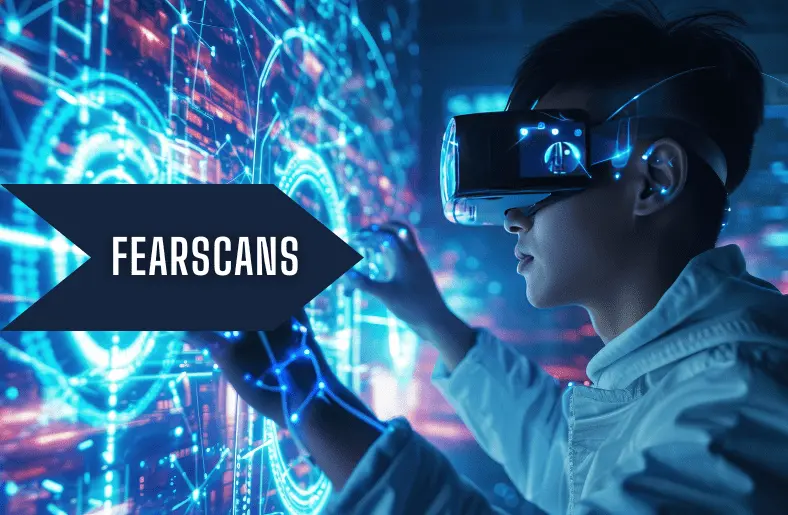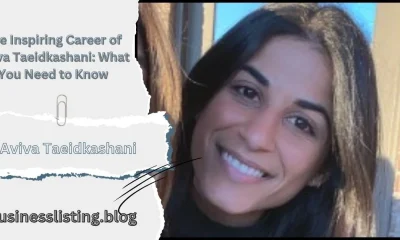Life style
FearScans: Understanding and Managing Fear Through Technology
Published
9 months agoon
By
Henry
Fear is a natural human emotion that can alert us to danger, prepare us for action, and even motivate us to change. However, when fear becomes excessive or irrational, it can interfere with our daily lives. Enter FearScans—an innovative approach that combines technology with psychology to help individuals understand and manage their fears. In this article, we’ll explore what FearScans are, how they work, their benefits, and strategies for utilizing them effectively.
What Are FearScans?
Fear-Scans refer to a variety of technological tools designed to measure, analyze, and help manage fear responses. They often incorporate biometric sensors, psychological assessments, and machine learning algorithms to assess a person’s emotional state and provide insights into their fears. By understanding the physiological and psychological aspects of fear, individuals can better cope with and address their anxieties.

The Components of FearScans
- Biometric Sensors: These devices measure physiological responses such as heart rate, skin conductance, and brain activity. For example, wearables can track changes in heart rate variability, which can indicate stress or anxiety levels.
- Psychological Assessments: Standardized questionnaires and interviews help identify specific fears, their triggers, and the intensity of the fear experienced. These assessments can provide a comprehensive view of an individual’s fear profile.
- Data Analysis and Feedback: Using machine learning algorithms, FearScans analyze the collected data to identify patterns and correlations. Users receive personalized feedback, helping them understand their fear responses better.
The Science Behind Fear
To appreciate the effectiveness of Fear-Scans, it’s important to understand the science of fear. Fear is primarily a survival mechanism, rooted in our evolutionary history. It involves several key components:
- The Amygdala: This almond-shaped structure in the brain plays a crucial role in processing fear. When we perceive a threat, the amygdala triggers the fight-or-flight response, releasing hormones like adrenaline and cortisol.
- Physiological Responses: Fear activates various bodily responses, including increased heart rate, rapid breathing, and heightened alertness. These reactions prepare us to respond to danger.
- Psychological Impact: Fear can lead to anxiety, panic attacks, and phobias if not managed effectively. It can also create a feedback loop where fear perpetuates itself, leading to avoidance behaviors and increased anxiety.
How FearScans Work
Step 1: Assessment
The first step in using Fear-Scans involves a comprehensive assessment. Users wear biometric sensors while answering psychological questionnaires. This process helps identify baseline physiological responses and specific fears or phobias.
Step 2: Data Collection
As users encounter situations that trigger their fears—whether through virtual simulations, real-life exposure, or guided scenarios—biometric data is collected. This information reveals how their body reacts to fear-inducing stimuli.
Step 3: Analysis and Feedback
The collected data is analyzed to identify patterns in the individual’s fear responses. Users receive feedback on their physiological and emotional reactions, helping them understand the triggers and intensity of their fears.
Step 4: Intervention Strategies
Based on the analysis, personalized intervention strategies are developed. These may include exposure therapy, mindfulness practices, or cognitive-behavioral techniques to help manage and reduce fear responses.
Benefits of FearScans
1. Personalized Insights
Fear-Scans provide tailored insights into individual fear profiles. Understanding specific triggers and physiological responses can empower users to confront and manage their fears effectively.
2. Objective Measurements
Unlike traditional self-reported measures of fear, FearScans offer objective data. This can reduce bias and provide a more accurate picture of an individual’s fear responses.
3. Enhanced Coping Strategies
By analyzing fear responses, users can develop more effective coping strategies. Fear-Scans can suggest techniques that are tailored to an individual’s specific needs, improving the likelihood of success.
4. Real-Time Monitoring
With wearable technology, users can monitor their fear responses in real-time. This can help individuals recognize when they are becoming anxious and implement coping strategies before the situation escalates.
5. Accessibility
FearScans can be more accessible than traditional therapy for some individuals. They can be used at home, reducing the need for frequent therapy sessions while still providing valuable insights.
Practical Applications of FearScans
1. Therapeutic Settings
Mental health professionals can integrate FearScans into therapy sessions. By using biometric data, therapists can better understand their clients’ fears and tailor interventions accordingly.
2. Workplace Wellness Programs
Organizations can implement FearScans in workplace wellness programs to help employees manage stress and anxiety. By promoting a culture of mental well-being, companies can improve employee satisfaction and productivity.
3. Educational Environments
FearScans can be utilized in schools to support students dealing with anxiety or performance-related fears. This technology can help educators identify at-risk students and provide timely interventions.
4. Self-Help and Personal Development
Individuals can use FearScans for self-exploration and personal development. By understanding their fears, they can embark on a journey of growth, resilience, and empowerment.
Limitations of FearScans
While FearScans offer promising benefits, there are limitations to consider:
- Data Privacy: The collection of biometric data raises concerns about privacy and security. Users must ensure that their data is stored and managed securely.
- Reliance on Technology: Over-reliance on technology may detract from the importance of human connection and traditional therapeutic approaches.
- Variability in Responses: Individual responses to fear can vary widely. What works for one person may not be effective for another, making it essential to personalize interventions carefully.
- Understanding Data: Users may find it challenging to interpret biometric data without proper guidance. Education about how to read and respond to this data is crucial for effective use.
FAQs About FearScans
1. What types of fears can FearScans help with?
FearScans can assist with a wide range of fears, including phobias, social anxiety, performance anxiety, and generalized anxiety. The technology is adaptable to various situations.
2. How accurate are FearScans?
The accuracy of FearScans depends on the quality of the sensors and algorithms used. While they provide valuable insights, they should be used in conjunction with professional guidance.
3. Can FearScans replace therapy?
While FearScans can enhance therapeutic processes and provide valuable insights, they should not replace traditional therapy. They are best used as a complementary tool.
4. How can I start using FearScans?
You can begin by researching available FearScan technologies and identifying those that fit your needs. Consulting a mental health professional familiar with these tools is also advisable.
5. Are FearScans safe to use?
FearScans are generally safe, but individuals should consult with healthcare providers before using any new technology, especially if they have pre-existing health conditions.
6. What if I find the data overwhelming?
If the data becomes overwhelming, it’s essential to seek support from a mental health professional. They can help interpret the data and provide strategies for managing fear.
Conclusion
Fear is an inevitable part of the human experience, but it doesn’t have to control our lives. FearScans offer a promising approach to understanding and managing fear through the integration of technology and psychology. By providing personalized insights, objective measurements, and real-time feedback, FearScans empower individuals to confront their fears and develop effective coping strategies.
As technology continues to evolve, so too will our understanding of fear and how to manage it. Embracing tools like FearScans can lead to greater emotional resilience, improved mental health, and a more fulfilling life. Whether you’re seeking to overcome specific phobias or simply looking to understand your fear responses better, FearScans may offer the guidance you need to take the next step on your journey to emotional well-being.
You may like
Life style
GVF90433S Gama Hot Water Heater: A Comprehensive Review with FAQs
Published
5 months agoon
February 6, 2025By
Harry
When it comes to hot water systems, homeowners and businesses alike seek reliable and efficient solutions that ensure a steady supply of hot water. The GVF90433S Gama Hot Water Heater has emerged as one of the most sought-after options in the market. With advanced technology, user-friendly features, and reliable performance, the GVF90433S promises to meet a wide range of hot water needs. This article will dive into the key features, specifications, installation, and maintenance of this hot water heater, while also answering frequently asked questions (FAQs) that can help potential buyers make an informed decision.
Overview of the GVF90433S Gama Hot Water Heater
The GVF90433S Gama Hot Water Heater is a high-performance, energy-efficient appliance designed to deliver consistent and reliable hot water for both residential and commercial applications. It is widely regarded for its durability, ease of use, and advanced safety features. Whether you’re upgrading your current water heater or installing one in a new home or business, the GVF90433S promises to deliver long-lasting performance.
Key Features of the GVF90433S Gama Hot Water Heater
1. Energy Efficiency
One of the standout features of the GVF90433S is its energy efficiency. This model is designed to minimize energy consumption, which can lead to significant savings on electricity bills over time. By using advanced heating elements and an efficient thermal insulation system, the heater ensures that hot water is available whenever needed without wasting energy.
2. Fast Heating
The GVF90433S is equipped with a high-efficiency heating element that allows for rapid water heating. It can provide hot water in a short amount of time, even during peak demand periods. This feature is particularly useful for households with high hot water usage or businesses such as hotels and restaurants that require continuous hot water.
3. Smart Temperature Control
With the GVF90433S, users can precisely control the water temperature to suit their preferences. The heater features a smart thermostat that automatically adjusts the temperature to ensure that water is heated to the desired level. This not only enhances comfort but also contributes to energy savings by preventing overheating.
4. Durability and Longevity
Built with high-quality materials and advanced technology, the GVF90433S is designed to last for many years. Its robust construction helps prevent wear and tear, even in high-demand environments. The heater’s corrosion-resistant materials ensure that it continues to perform optimally, even in areas with hard water.
5. Safety Features
Safety is a top priority for Gama, and the GVF90433S is equipped with several important safety features. These include over-temperature protection, automatic shut-off in case of malfunction, and pressure relief valves to prevent overheating or excessive pressure buildup. These safety features give users peace of mind, knowing that their water heater is safe to use.
6. Compact and Space-Saving Design
The GVF90433S is designed to fit into tight spaces, making it ideal for homes or businesses with limited room for large appliances. Its compact size allows it to be installed in a variety of locations, such as under-sink or in closets, without sacrificing performance.
7. User-Friendly Interface
The water heater is equipped with an easy-to-use control panel that allows users to adjust settings quickly and intuitively. This user-friendly interface makes it simple to set the desired water temperature, monitor performance, and perform basic troubleshooting.
Specifications of the GVF90433S Gama Hot Water Heater
- Capacity: 9.5 gallons per minute (GPM)
- Heating Method: Electric
- Voltage: 240V
- Energy Factor: 0.95
- Temperature Range: 90°F to 150°F
- Dimensions: 18 inches (W) x 42 inches (H)
- Weight: 65 lbs
- Warranty: 5 years
- Safety Features: Over-temperature protection, pressure relief valve, automatic shut-off
Installation of the GVF90433S Gama Hot Water Heater
Installing the GVF90433S Gama Hot Water Heater is a straightforward process, but it is recommended that a licensed professional handle the installation to ensure safety and proper functioning. Here’s a general outline of the installation steps:
1. Choose the Installation Location
Select a location that has access to a water supply and electrical power. The space should be well-ventilated and away from combustible materials. Ensure that the space is large enough to accommodate the dimensions of the water heater.
2. Prepare the Water Supply
Connect the cold water supply line to the inlet valve on the heater, ensuring that all connections are secure and leak-free. Next, connect the hot water outlet to the distribution pipes that supply hot water to various fixtures in the building.
3. Electrical Connection
The GVF90433S requires a dedicated electrical circuit. Connect the heater to the power supply, making sure that the voltage is consistent with the manufacturer’s specifications. A professional electrician should perform this step to avoid electrical hazards.
4. Check for Leaks
Once everything is connected, turn on the water supply and check for leaks. If there are any leaks, tighten the connections or replace any faulty components.
5. Test the Heater
Once installed, test the heater by turning on the power and adjusting the thermostat to the desired temperature. Allow the water heater to run for a few minutes to ensure proper functionality.
Maintenance of the GVF90433S Gama Hot Water Heater
Proper maintenance is essential for the longevity and efficient operation of your GVF90433S Gama Hot Water Heater. Here are a few key maintenance tips:
- Regularly Check for Leaks: Inspect all connections for signs of leakage, especially around the inlet and outlet valves.
- Flush the Tank: Over time, sediment may build up in the tank, reducing the efficiency of the heater. Flushing the tank every 6–12 months can help maintain its performance.
- Test the Safety Features: Periodically test the safety features such as the over-temperature protection and pressure relief valve to ensure they are functioning correctly.
- Inspect the Heating Elements: Inspect the heating elements for wear and tear. If they are damaged, replace them to maintain optimal performance.
- Professional Servicing: It’s recommended to have a professional technician perform an annual inspection to ensure the heater is operating at peak efficiency.
Frequently Asked Questions (FAQs)
1. What is the energy efficiency of the GVF90433S Gama Hot Water Heater?
The GVF90433S has an energy factor of 0.95, making it highly energy-efficient and cost-effective for long-term use.
2. Can the GVF90433S be installed in a small space?
Yes, the GVF90433S has a compact design, making it suitable for installation in tight spaces such as closets or under-sink areas.
3. How do I set the desired temperature on the GVF90433S?
The heater features a user-friendly control panel with an adjustable thermostat, allowing you to set the temperature between 90°F and 150°F with ease.
4. Is the GVF90433S safe to use?
Yes, the GVF90433S is equipped with several safety features, including over-temperature protection, pressure relief valves, and automatic shut-off in case of malfunction.
5. What is the warranty for the GVF90433S?
The GVF90433S comes with a 5-year warranty, which covers parts and certain types of damage under normal use.
6. How long does it take for the GVF90433S to heat water?
The GVF90433S is designed to heat water quickly, with the time varying depending on the amount of water being heated and the temperature setting. Typically, it can provide hot water in a matter of minutes.
7. Can I install the GVF90433S myself?
While the installation process is relatively simple, it is recommended to hire a licensed professional to ensure safety and proper operation.
Conclusion
The GVF90433S Gama Hot Water Heater is an excellent choice for homeowners and businesses seeking an efficient, durable, and safe hot water solution. With its energy-efficient operation, fast heating time, and user-friendly features, it is well-suited for a variety of applications. By following the installation and maintenance guidelines, users can enjoy reliable hot water for years to come. If you’re considering upgrading your hot water system, the GVF90433S is certainly worth considering for your needs.
Life style
Mary Marquardt: A Journey of Independence, Strength, and Personal Growth
Published
6 months agoon
January 7, 2025By
Harry
Mary Marquardt is a name that may not immediately ring bells in the world of celebrities, but for those who know her story, she is a figure of resilience, growth, and independence. Mary Marquardt gained widespread recognition as the ex-wife of Harrison Ford, one of Hollywood’s most iconic actors, but her story transcends her connection to the famous actor. Over the years, she has carved out a life filled with self-reliance and personal accomplishments, separate from her ex-husband’s spotlight.
This article delves into the life of Mary Marquardt—her early years, her marriage to Harrison Ford, her life after their divorce, and her subsequent endeavors. In addition, we will explore the impact of her personal journey on her life and the lives of those who know her, offering a closer look at the woman behind the headlines.

Early Life and Background
Mary Marquardt was born on November 12, 1950, in the United States. Although information about her early life and childhood is relatively scarce, it is known that she grew up in a typical American household, in a middle-class environment. Her upbringing, however, would have had an undeniable influence on her character, providing her with a strong foundation in values such as hard work, family, and determination.
Marquardt attended Ripon College in Ripon, Wisconsin, where she pursued a degree in Chemistry. She had a passion for science, and her academic journey in this field is one of the few details that have emerged about her pre-Hollywood life. Her intellectual curiosity and pursuit of knowledge were key traits that she maintained throughout her life, both personally and professionally.
Though Marquardt’s early life has been kept private, it is clear that she had a solid foundation in education and personal ambition—traits that would serve her well as she navigated her life with and after Harrison Ford.
Marriage to Harrison Ford: A Glimpse into Their Life Together
Mary Marquardt became widely known after her marriage to Harrison Ford, who would go on to become one of the most beloved and successful actors in Hollywood. The two met in the late 1960s while Ford was still an aspiring actor, trying to break into Hollywood. At the time, Ford was not yet the famous star known for his roles in iconic franchises like Star Wars and Indiana Jones.
The couple married in 1964, when Ford was just starting his career in film and television. Their relationship, though grounded in mutual respect and love, faced many challenges, especially as Ford’s career began to take off. Marquardt and Ford had two sons during their marriage, Ben Ford and Willard Ford. Ben Ford would later become a chef, while Willard Ford would pursue a career in business and entrepreneurship.
Ford’s rising fame played a significant role in their relationship dynamics. As his Hollywood profile grew, it became increasingly difficult for Mary Marquardt to maintain a sense of normalcy in her life, especially when the media began to focus on the private lives of celebrities. Despite these challenges, Marquardt reportedly remained supportive of Ford, and the couple had a stable family life for several years. However, as is often the case in the entertainment industry, the pressures of Ford’s career took a toll on their relationship.
After over a decade of marriage, the couple ultimately divorced in 1979. The reasons behind their divorce remain private, but it is believed that the strain caused by Ford’s skyrocketing career, combined with the typical stresses of marriage, contributed to their separation.
Life After Divorce: Independence and Personal Growth
Mary Marquardt’s life post-divorce from Harrison Ford marked a period of significant personal growth and independence. In the years following their separation, she chose to stay out of the limelight, and very little is known about her life in the media. Unlike many ex-wives of famous celebrities who continue to be in the public eye, Marquardt took a step back from Hollywood culture and focused on living a private, fulfilled life.
While her ex-husband moved on with a high-profile relationship with actress Calista Flockhart, which eventually led to marriage, Marquardt opted to remain outside the Hollywood spotlight. This decision spoke volumes about her desire for privacy and self-sufficiency. It is said that she devoted herself to her work and her children, raising them with a sense of normalcy despite their father’s fame.
Her quiet life allowed her to focus on personal endeavors. One significant area of her life was her ongoing pursuit of science and chemistry, which was her passion even before her marriage to Ford. While not much is known about her career after her marriage, it is widely believed that she continued to work in scientific fields, potentially in research or a similar role where she could make use of her skills.
Though the public has largely remained in the dark about her personal life after the divorce, it is clear that she valued her independence, her intellectual pursuits, and her ability to define herself beyond her relationship with Ford.
Mary Marquardt: A Mother and Family Woman
One of the most important roles in Mary Marquardt’s life has been that of a mother. She raised her two sons, Ben and Willard Ford, largely outside of the public eye, providing them with a stable and grounded environment. Both of her sons have achieved success in their respective fields, with Ben Ford becoming a renowned chef and Willard Ford pursuing a career in business. While their father, Harrison Ford, is undoubtedly a figure in their lives, it is clear that Mary Marquardt played a pivotal role in shaping their values and guiding them through their formative years.
Marquardt’s ability to focus on her family, even in the shadow of Hollywood fame, speaks to her character. In a world that often places celebrity relationships under intense scrutiny, she chose to prioritize her children’s well-being and independence over fame and public attention.
Her children, in return, have expressed admiration for their mother’s steadfast nature, her commitment to her family, and her determination to maintain a low profile despite her connection to one of the world’s most famous actors.
Mary Marquardt’s Legacy: A Quiet Strength
Mary Marquardt’s legacy is not defined by her connection to Harrison Ford, but by the strength, independence, and resilience she exhibited throughout her life. While many ex-wives of high-profile figures continue to maintain a presence in the public sphere, Marquardt has carved out a different path—one that values privacy, intellectual curiosity, and family.
Her legacy is also defined by her quiet perseverance. After a highly publicized divorce, she took steps to ensure that she and her children could live their lives away from the prying eyes of the media. This decision has allowed her to build a life that, while private, is one of significant personal achievement.
Through her dedication to her career, her role as a mother, and her ability to live outside the shadow of Hollywood’s relentless spotlight, Mary Marquardt continues to serve as a model of grace, independence, and strength for women everywhere.
FAQs about Mary Marquardt
Q: Who is Mary Marquardt?
A: Mary Marquardt is a former celebrity spouse best known as the ex-wife of actor Harrison Ford. Though her connection to Ford brought her into the public eye, Marquardt is known for maintaining a private life focused on her family, career, and personal growth.
Q: When was Mary Marquardt married to Harrison Ford?
A: Mary Marquardt married Harrison Ford in 1964. The couple divorced in 1979 after 15 years of marriage.
Q: Does Mary Marquardt have children?
A: Yes, Mary Marquardt has two children with Harrison Ford: Ben Ford, a chef, and Willard Ford, a businessman.
Q: What did Mary Marquardt do after her divorce from Harrison Ford?
A: After her divorce, Mary Marquardt largely stayed out of the public eye. She is believed to have continued her work in chemistry or a related field, and she focused on raising her children away from the media spotlight.
Q: Why is Mary Marquardt considered a role model for women?
A: Mary Marquardt is considered a role model for her strength, independence, and dedication to her family. Despite being married to one of Hollywood’s biggest stars, she chose to live a private life focused on her children and career, showing that one’s identity is not solely defined by a marriage to a celebrity.
Q: What is known about Mary Marquardt’s career?
A: While details about her career are limited, it is known that she pursued a degree in chemistry from Ripon College and has continued to work in scientific fields, although the specifics are unclear. She is primarily known for her role as a mother and for leading a low-key life after her marriage to Harrison Ford.
Conclusion
Mary Marquardt’s life is a testament to the strength of personal growth, independence, and the importance of family. While her ex-husband, Harrison Ford, remains a Hollywood icon, she has built her own legacy, one that emphasizes privacy, self-reliance, and resilience. As the ex-wife of one of the most famous actors in the world, she has remained out of the limelight, choosing instead to live a fulfilling, private life. Through her quiet strength, Mary Marquardt continues to inspire women who seek independence and personal fulfillment, proving that one’s legacy can be shaped by their actions, not their connections.
Life style
Understanding Ciulioneros: History, Culture, and Significance
Published
7 months agoon
November 19, 2024By
Harry
The term “Ciulioneros” refers to a group of people and a unique cultural identity associated with a particular region. However, due to the relative obscurity of this term, it’s essential to clarify that its meaning and significance can vary depending on the context in which it’s used. This article will delve into the history, cultural roots, and possible interpretations of the term “Ciulioneros” across different settings.
1. What Are Ciulioneros?
The word “Ciulione-ros” is not a widely recognized term in mainstream history or anthropology. As of now, there are no major historical events, empires, or well-documented communities universally known as Ciulione-ros. However, some local legends and folk traditions use the term to describe a specific ethnic group, a type of music, or even a regional lifestyle. The ambiguity of the term may come from its use in oral traditions or local dialects that are not formally recorded in global academic references.
It’s possible that “Ciulione-ros” could refer to a particular tribe, clan, or group within a specific geographical region that has not gained widespread attention. Alternatively, it might be a subcultural term linked to a distinct style of music, artistic expression, or local ritual that’s celebrated in a small community or region.
2. Origins and Etymology
The origins of the word “Ciulione-ros” remain unclear, and different theories may explain how the term came about. Some believe that it might be derived from an indigenous language of a specific area, while others speculate that it is a fusion of various cultural influences—especially if it refers to a community that has undergone significant cultural blending over time.
Etymologically, “Ciulione-ros” might be related to the word “ciulion,” which could derive from ancient terms used to describe local customs, traditions, or even geographic landmarks. There may be a connection to a type of craft, song, or ritual that was originally unique to a certain region, and over time, the term expanded to include the people who practiced those traditions.
3. Geographical Distribution
Although specific locations associated with the term “Ciulione-ros” remain undetermined, it is conceivable that this group originated from a particular region—possibly in areas of Eastern Europe, the Mediterranean, or parts of South America. These areas are often home to various ethnicities and communities whose names and identities evolve with time and language shifts.
Some researchers suggest that the term may relate to local groups in rural or remote areas where cultural traditions are preserved. For instance, isolated mountain communities or river settlements might have coined this term as part of their internal social structure. Alternatively, it may relate to a community that traces its origins to a colonial past or the blending of indigenous and European elements.
4. Cultural Practices and Traditions
Though there is limited information on specific practices of the Ciulione-ros, we can make educated guesses based on similar cultural groups. If Ciulioneros are indeed an ethnic or social group, they likely have unique cultural practices, ceremonies, and art forms that reflect their historical and geographical roots.
For example, they might have traditional dances, music, and folk stories that distinguish them from neighboring communities. The term “Ciulioneros” might also be associated with craftsmanship, such as pottery, weaving, or other artisanal skills. Additionally, it’s possible that their social organization reflects a particular way of living, with communal living arrangements or specific roles designated to various members of the group.
In some cases, groups like the Ciulioneros may preserve a form of language or dialect, which, although not widely known, serves to unite them and maintain cultural continuity across generations.
5. Ciulioneros and Music
Another possible interpretation of the term “Ciulioneros” involves music. Many indigenous and rural communities worldwide have a particular style of music that is deeply embedded in their social rituals and daily life. “Ciulioneros” could be a reference to a genre of folk or traditional music that is either performed by or inspired by this community.
The music of the Ciulioneros might feature unique instruments or vocal styles, and it may play a critical role in marking important life events, such as births, marriages, or harvests. Folk music often serves as a cultural bridge, passing down histories, stories, and values from one generation to the next. If this is the case, the music of the Ciulioneros would likely be considered a vital expression of their identity and heritage.
6. Ciulioneros and Folklore
The folklore of the Ciulioneros could also be an integral part of their identity. Like many traditional cultures, they may have legends, myths, and stories that explain their origins, their relationship with nature, and their place in the broader world. These tales could be passed down orally through generations, with each retelling adding layers of meaning and significance.
One prominent feature of folklore from various cultures is the concept of a hero or a spiritual guide, who embodies the values and ideals of the community. Perhaps the Ciulioneros have a similar figure—a legendary character who teaches moral lessons, preserves the history of the group, or provides guidance in times of crisis.
FAQs on Ciulioneros
1. What are the key cultural characteristics of the Ciulioneros?
The cultural characteristics of the Ciulioneros remain somewhat unknown, as the term is not widely recognized or documented in major cultural studies. However, it is likely that their culture includes distinctive arts, music, and rituals that reflect their unique historical and social context. These cultural elements would be integral to their identity and community life.
2. Are the Ciulioneros associated with a particular country or region?
While it’s difficult to pinpoint an exact geographical region for the Ciulioneros, the term could apply to isolated or rural communities in various parts of the world, including Eastern Europe, South America, or parts of the Mediterranean. More research would be needed to definitively associate them with a specific place.
3. Do Ciulioneros have their own language or dialect?
It is possible that the Ciulioneros speak a unique dialect or even have a distinct language. Many traditional communities develop their own forms of communication, which can be influenced by historical, social, and geographical factors. However, there is no concrete evidence at this point to suggest that the Ciulioneros possess a widely-recognized language or dialect.
4. Is there a specific style of music associated with the Ciulioneros?
Yes, there might be a style of folk or traditional music that is associated with the Ciulioneros. This music could be an essential part of their social rituals and cultural practices. It might involve the use of traditional instruments and unique singing styles, serving both as entertainment and a means of storytelling.
5. Do the Ciulioneros practice any religious rituals or beliefs?
If the Ciulioneros are a cultural group with strong traditions, they may have particular spiritual or religious beliefs, often tied to nature or ancestral worship. These beliefs would likely be expressed through ceremonies, festivals, and other communal activities that reinforce their connection to the land and their ancestors.
6. How can I learn more about the Ciulioneros?
Since the term “Ciulioneros” appears to be relatively obscure, there may not be a wealth of readily available academic or historical sources. However, you can explore ethnographic studies, local histories, or even folklore from specific regions where the term may have originated. Engaging with local communities, cultural experts, and historians in the relevant areas could provide more insight into the customs and significance of the Ciulioneros.
7. What role does folklore play in the identity of the Ciulioneros?
Like many traditional cultures, the Ciulioneros are likely to have a rich tradition of folklore. This folklore would not only entertain but also educate, preserve history, and foster a sense of unity and identity within the community. Stories about heroes, gods, or significant historical events would serve to strengthen communal bonds and provide a framework for understanding their place in the world.
8. Are there any known groups or societies specifically called Ciulioneros today?
As of now, there is no widespread recognition of a group explicitly named “Ciulioneros” in major academic or cultural references. However, it’s possible that smaller, lesser-known communities in rural or isolated areas might self-identify by this term. More localized or regional studies might shed light on this.
Conclusion
The term “Ciulioneros” remains shrouded in mystery, with limited documentation or public awareness of its exact meaning and historical context. Whether it refers to an ethnic group, a style of music, or a community with distinct cultural practices, the concept of Ciulioneros offers an intriguing glimpse into the complexities of identity, tradition, and heritage.
As research continues and new findings emerge, the rich and varied cultural history of groups like the Ciulioneros may eventually come into clearer focus, enriching our understanding of diverse global traditions.
Trending
-

 News9 months ago
News9 months agoKaterina Goltzwart: A Multifaceted Talent in the Creative Realm
-

 News9 months ago
News9 months agoAviva Taeidkashani: A Profile of Inspiration and Leadership
-

 Tech9 months ago
Tech9 months agoCrypto Archives on NewzNav: A Deep Dive into the Future of Digital Finance
-

 Life style9 months ago
Life style9 months agoThe Joy of Laughter: A Deep Dive into Its Benefits and Impact
-

 Business9 months ago
Business9 months agoArgentstate: A Comprehensive Exploration of the New Frontier in Digital Currency
-

 Life style9 months ago
Life style9 months agoChelsea Acton: A Pioneer in Parenting and Family Dynamics
-

 News9 months ago
News9 months agoMastering Video Content Creation: The Ultimate Guide to zVideo
-

 entertainment9 months ago
entertainment9 months agoEiyuu to Kenja no Tensei Kon: A Journey Through Fantasy and Reincarnation
